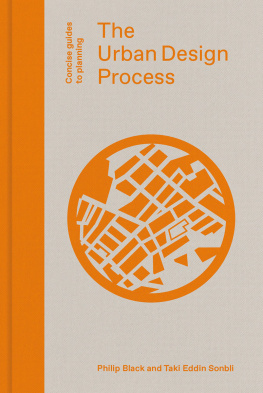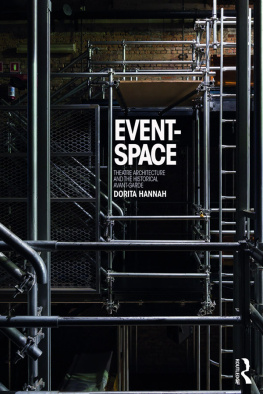
ALL OVER THE MAP
Writing on Buildings and Cities
MICHAEL SORKIN

To my students
Contents
The majority of the pieces in this collection were first published in Architectural Record magazine and Id like to thank Robert Ivy and Clifford Pearson for offering me a place to say pretty much what I chose for so many years. A couple of the longer essays appeared in the Harvard Design Magazine and Im indebted to William Saunders for his staunch support and encouragement. Many of the 9/11-related pieces in this volume were collected in Starting from Zero and Id like to give a shout out to the great Dave McBride, formerly of Routledge, who saw that volume through. (I did debate leaving these pieces out but the volume seemed wrong without them, and so Ive included a substantial selection, some trimmed, others merged to eliminate repetition and breathless deadline lapses. Forbearance please for remaining auto-cannibalization, self-plagarism and the overworking of many words and phrases, including Manichean, difference, effects, public-private partnerships, and zillions.) Thanks too to Tom Penn for his comradely midwifery and to Verso for a third vote of confidence in this fellow traveler. Special thanks to Trudy Giordano, Maia Peck, and Zo Blackler for their help in organizing the manuscript and tracking down many a misplaced file.
The period covered in this volume coincides with my directorship of the Graduate Program in Urban Design at the City College of New York, and I express my gratitude to my dear friend Dean George Ranalli for giving me an open space in which to work (not to mention tenure and health insurance) and for helping to gather a congenial and dedicated group of colleagues to further the mission of this extraordinary institution. While the Trots and the Stalinoids may no longer throw spitballs from their separate tables at the cafeteria, CCNY continues its grand tradition of progressive tolerance and its goal of making higher education available to all. I do love the thrill each year of welcoming students from across the planet to share the adventure of imagining happy, just, and sustainable futures for our cities. I dedicate this volume to them.
About twenty years agoat the height of the historicist belch of architectural PoMoI taught a studio at the University of Pennsylvania. One day, as I strolled into the building fresh from the train, I came upon an exhibition of drawings of student projects all done in the then fashionably phony-baloney classical style (just following the orders), rendered in dispiriting watercolor washes and brown ink. Rounding a corner, I came upon the great Aldo van Eycka hero from my own student dayswho was also teaching at the school that semester. He was in the process of ripping the drawings from the wall in a fury. People rushed from nearby offices, horrified. Indeed, I was somewhat horrified myself, having seen the work of my own students at Columbia vandalized by someone who disagreed with my purportedly wild approachan outrage. Confronted by the dean, Van Eyck ceased his trashing and, when asked how he could do such a thing, delivered the memorable line: Democracy means no freedom for fascism.
Baldly stated, but telling. Van Eyck was testing the line between free expression and what he saw as architectural hate speech, one of the primary negotiations of a democratic polity. Architecture can never be a purely private event, and unpacking the elasticity of public space and its ability to stimulate, accommodate, or suppress diverse (and unpredicted) forms of individual and collective expression has underlain much of my work, both written and drawn. Make no mistake: there is a crisis in the public realm and its grossest manifestations range from car bombs in Kabul to CCTV cameras in London, from defensive street furniture in Manhattan to the rampant privatization of everything. No matter how you slice it, a shopping mall will never be a public square, nor men with guns the mark of the open city. The focus of my projectwhether via critique or proposalhas been on the ways in which such issues find their meaning in form... and forms of redress.
The essays in this book are, in large part, shaped by a series of American disasters, each of which has caused a special crisis for spatial liberation. This anthology takes up where my last one left off, late in 2000. In November of that year, George W. Bush was elected to the US presidency. Less than a year after that, the 9/11 attacks took place. Then the wars in Iraq and Afghanistan. In 2005, Hurricane Katrina struck the Gulf Coast, laying bare the egregious divisions of race and class that had only deepened under the rule of Bush and his corporatist wantons, and throwing into relief the real ramifications of the swelling debate over climate change. That in the midst of these nightmares the formal side of architecture continued to enjoy a remarkable efflorescence is not exactly paradoxicalperiods of great accumulation from the Pharaohs to the Medici to the sheiks of the Emirates to the Masters of the Universe on Wall Street will beget monumentsbut it begged the question that has perplexed me from the start of my career: how to simultaneously value artistic expression largely directed to the privileged and to rail against a world going to hell in a hand-basket because of a crisis in equity.
There is no simple formulation for this, and I apologize if my practices can seem a skosh schizophrenic: Ive denounced the perquisites of big money in print while simultaneously designing a fancy hotel in the office. In exculpation, I can only beat my breast and suggest that theres a certain Peter/Paul strategy of compensatory practice. Even my studio is now physically divided in two with its for-profit (I wish!) and its non-profit sides. My own room straddles the demising wall designed for the IRS and, as the for-profit side pays for it all, the arrangement is the spatial signifier of donated time. Looking over the writing in this and previous volumes, though, I can see that the textsunlike the 50/50 implication of the virtual division of my officeare strongly weighted to the social side. For that matter, so is the designing, particularly in a long specialization in urbanism, work at a scale that can genuinely be judged for its public arrangements and effects.
In fact, scale and organizational complexity are crucial to a distinction between architecture as an effect and as a producer of effects, whether social, political, environmental or aesthetic. The sumptuary architectures of the Republican decadesfrom McMansions to museumscan surely be read as effects of a commercialized culture, of seductive (and deceptive) interest rates, of an increased inurement to inequality and planetary peril. This must be decried. The problem, though, in dealing with an art form that is defined by the fact of its necessarily extra-artistic content and behavior is always in testing the implications of the differingand sometimes competingclaims on it. No work of architecture can presently be judged without considering its impact on the natural environment. Nor should any work be exempted from consideration of its styles of collaboration in securing the common space of exchange among people and publics. But we must never criminalize the pursuit of the beautiful, nor depend on the simple vulgarity of arguments that the artistic superstructure is the deterministic outcome of some economic or political base. The work in this volume is informed by the fact, however nuanced or indirect, of a connection.
If theres an area of conflict in writing about architectural projects that represent enormous expenditure on luxury objects, the necessity of doing so springs from a few motives. One is that a beautiful and pleasurable architectural experience always inspires, provided its use isnt an overwhelming affront. Another is to hold the feet of my brother and sister architects to the fire for the insensitivity of their egregious money-grubbing and for the vapid, end-of-history (or hermetically arcane) explanations that seek to naturalize such practices as the only alternative. Still another has been to insist that the discourse of architectural and urban effects must be understood in terms of its invariable relevance to our planetary environmental meltdown. Building is responsible for nearly half of the carbon emissions that are wreaking such planetary havoc, and the differential rates of consumptionof materials, of energy, of space, clean air, labor, capitalembodied in construction make the crisis clear. A much rehearsed but telling example is the simple fact that were everyone in the world to consume at the American rate, the surface area of two additional planets would be required to supply all the stuff. We are up against real limits, and architecture can be decisive. Finally, I have never hesitated to call architects on doing work thats truly inimical to justice, whether that work is the instrument of the displacement of living communities, window dressing for repressive regimes or toxic ideologies, the medium of imprisonment and surveillance, or the distributor of ill-gotten gains. And, by extension, Ive been intolerant of the criticism and theorizing that abets all of this.
Next page










